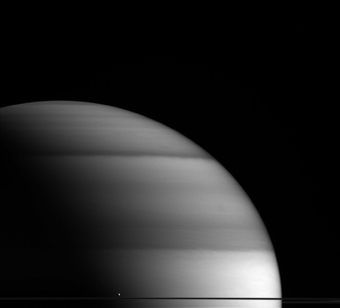
Image courtesy of Cassini/NASA/JPL
Enceladus Drop of Dew
| published May 3, 2016 |
By Keith H. Roberts, Thursday Review contributor
Sometimes it is difficult to grasp the massive size of our solar system’s giants. Saturn, the second largest planet in the solar system after Jupiter, is some 120,536 kilometers in diameter at its equator, with a mass roughly 95 times the size of Earth. Saturn’s orbit is therefore powerful and generally inescapable—thus its rather crowded skies of rings and moons, more than 60 moons total.
Enceladus, Saturn’s sixth largest moon at more than 500 kilometers (313 miles) in diameter, is dwarfed by Saturn’s immense size in this photo taken from the Cassini spacecraft. Here, according to NASA, Enceladus looks to be a mere droplet of dew resting upon a leaf—in this case the leaf being the smooth, thin plane of Saturn‘s elaborate but delicate ring system. The photo gives Earthbound viewers a true sense of the scale on objects in our solar system.
Unlike the many of Saturn’s moons, Enceladus is active geologically—filled with ice and water, and entire subsurface ocean, shifting plate tectonics, and even a plume (sometimes referred to as a geyser) of water vapor, dust, and ice fragments trailing from its southern pole. Enceladus orbits just inside the edge of Saturn’s E-ring.
Related Thursday Review articles:
Half Moon, Or Half Enceladus?; Thursday Review staff; Thursday Review; January 25, 2016.
Saturn in Repose; Thursday Review staff; Thursday Review; August 28, 2015.
